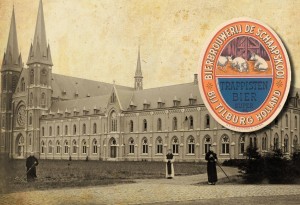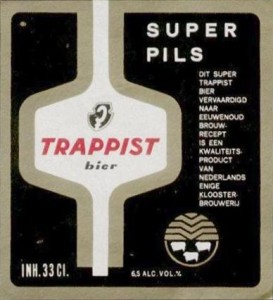Trappist Lager from the Sheep Barn
 Around 1891, a remarkable newcomer had appeared in the rapidly changing Dutch beer scene. That year, the brewers of the province of North Brabant wrote a request to no-one else but the pope. It read as follows: ‘Most holy Father! With deep respect the subscribers… ask for Your Fatherly blessing and permit themselves to tell Your Holiness that their business is seriously harmed by the practicing of a beer brewery by the Honourable Fathers Trappists.’[1] The brewers begged the pope to order the Trappists to stop brewing.
Around 1891, a remarkable newcomer had appeared in the rapidly changing Dutch beer scene. That year, the brewers of the province of North Brabant wrote a request to no-one else but the pope. It read as follows: ‘Most holy Father! With deep respect the subscribers… ask for Your Fatherly blessing and permit themselves to tell Your Holiness that their business is seriously harmed by the practicing of a beer brewery by the Honourable Fathers Trappists.’[1] The brewers begged the pope to order the Trappists to stop brewing.
If you’re a beer lover, the word ‘Trappist’ will probably make your mouth water. Especially when they are serious competition to commercial brewers. But hold on. What was going on here? In 1881 the first Trappists had arrived in Brabant, an area in the South of the Netherlands (Holland) that is traditionally Catholic. They came from France, and they tried to make a living farming near the village of Berkel-Enschot. Soon they found out that the poor heathlands yielded not enough. The monks then decided to brew beer. Wonderful, dark, tasty, top-fermenting doubles and triples? No, lager!
In 1884, brother Isidorus took the train to Munich to acquaint himself with the bottom-fermenting process. It was a commercial choice. At the time, most brewers in Brabant made top-fermenting beer, while the market demanded more and more bottom-fermented ‘Bavarian’ beer. When brother Isidorus had returned from brewing school, it took a while before the first Dutch Trappist brews could hit the market: while he was away, the abbey had inadvertently installed a top-fermenting brewery. But by 1886, everything was ready. The Schaapskooi (‘Sheep Barn’) brewery of Koningshoeven Abbey was a fact.
 After a few years, the monks started expanding their brewery in a way that, according to the other Brabant brewers, could be called ‘truly monstrous’. The monks had a modern brewery, hardly any wages to pay and because of their vow of poverty they didn’t really need to make a profit. Hardly surprising they were fierce competitors to the existing brewers. Not only in the Catholic South of Holland, but also all over the North there were advertising signs proclaiming: ‘Here is Trappist beer to be had.’ This first beer from Koningshoeven Abbey was of the Munich or Bavarian type: bottom-fermented but mostly dark. They only started brewing Pilsener in 1931.[2]
After a few years, the monks started expanding their brewery in a way that, according to the other Brabant brewers, could be called ‘truly monstrous’. The monks had a modern brewery, hardly any wages to pay and because of their vow of poverty they didn’t really need to make a profit. Hardly surprising they were fierce competitors to the existing brewers. Not only in the Catholic South of Holland, but also all over the North there were advertising signs proclaiming: ‘Here is Trappist beer to be had.’ This first beer from Koningshoeven Abbey was of the Munich or Bavarian type: bottom-fermented but mostly dark. They only started brewing Pilsener in 1931.[2]
Whether His Holiness responded to the brewers’ request in 1891, and in what terms, I have not been able to find out. In any case, the Trappists continued brewing their Bavarian beer. They did so with a few ups and downs, but by 1980 things changed for the better: the monks started brewing top-fermented beers, like their Belgian counterparts. Ironically, it was again a commercial decision. Belgian Trappist beers were starting to get popular worldwide, and Koningshoeven Abbey was happy to cash in. Today, under the name of ‘La Trappe’ they have a nice array of Belgian-style beers like double, triple and even a quadruple. However, their ‘Trappist Lager’ is now a ‘Lost Beer’ for good.[3]
[1] Nieuwe Gorinchemsche Courant, 19 March 1891.
[2] Jef van den Steen, Trappist. De zeven heerlijke bieren, Leuven 2010.
[3] This article was based on an earlier version in Dutch, http://verlorenbieren.nl/verloren-bieren-4-bier-uit-de-schaapskooi/.






Leave a Reply